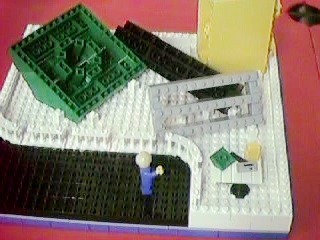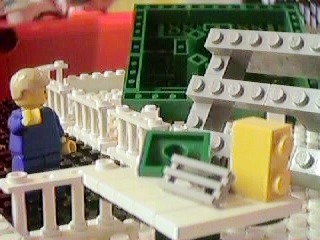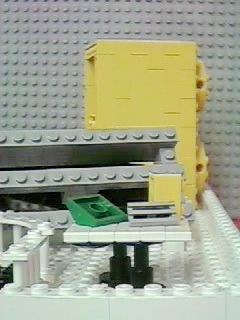The Museum of the Excessively Huge
"The Museum of the Excessively Huge" is the name of my entry in the Builder's Expo LEGO® model exhibit that took place at The Construction Site in August and September 1999. The Builder's Expo was not a competition.
In case you're having trouble figuring out what this is: It's a minifig (a little LEGO® "person") in a modern art museum looking at some sculptures which are actually giant LEGO® bricks made out of LEGO bricks. The giant bricks are 6 times normal size (or 216 times, if you count width x length x height). There are four giant bricks — a 2x2 green double-slope roof piece, a 1x2 yellow brick, a 1x2 gray tile with grille, and a #3 Technic cross axle. The red around the edges in the first two photos is just a countertop.
To aid the museum visitor, a miniature replica of the giant sculpture is presented on a table to the side. The miniature pieces (which are just normal actual-size LEGO® bricks) are arranged in the same arrangement as their large counterparts.

An overhead view
From left to right across the top: The 2x2 green roof piece, the black #3 Technic cross axle, and the 1x2 yellow brick. The 1x2 gray tile with grille is resting on the cross axle.

Microdave holds up his hand to gauge the relative size of the small and large models
In this picture, the large green object in the background is a large 2x2 double-slope green roof brick, and the large gray object is a 1x2 tile with grille.

Another view of the small and large models
This picture shows the 1x2 grille tile again and the large yellow 1x2 brick. For this photo I used a large gray baseplate as a background to reduce clutter in the photo.
Dimensions
Minifigs like Microdave are about 1/40 the height of real people. Based on a scale of 1:40, the actual LEGO bricks on the table would be 40 times normal size (from Microdave's point of view) and the large bricks would be 240 times normal size. In terms of volume, the large bricks would be 240 x 240 x 240 = 13,824,000 times normal size!
The large bricks do not completely fit each other in the same ways that their actual-size counterparts do — some combinations work and others don't. The combinations that don't work result mainly from the extra thickness added by the studs ("bumps"), a problem that could be solved with lots of tiles (the smooth thin LEGO® bricks). Unfortunately, tiles are fairly rare and I didn't have nearly enough to eliminate the studs in these models.
LEGO® creations index
The graph paper in my newer photos is ruled at a specing of 1 LSS, which is about 7.99 mm.
This site is not affiliated with the LEGO® group of companies.
LEGO®, Duplo®, QUATRO®, DACTA®, MINDSTORMS®, Constructopedia®, Robotics Invention System® and Lego Technic®, etc. are trademarks or registered trademarks of LEGO Group. LEGO Group does not sponsor, authorize or endorse this site.
All other trademarks, service marks, and copyrights are property of their respective owners.
If you want to visit the official LEGO® site, click here
Parts images are from LUGNET. On this page they explicitly give permission to link to the images:
Note: you may link (as in, Yes, it's OK) directly to these parts
images from an off-site web page.
This page was written in the "embarrassingly readable" markup language RHTF, and was last updated on 2012 Dec 30.
 s.27
s.27